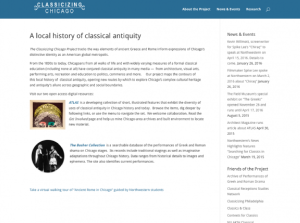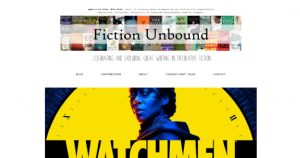Research and Education
Back to Top
|
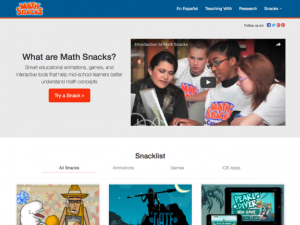 |
|
Math Snacks
|
Mathematics |
|
For upper elementary and middle school mathematics instructors looking to enhance their curriculum with engaging games, videos, and more, Math Snacks provides a number of free resources. Developed by New Mexico State University's Media Productions & Learning Games Lab, Math Snacks is a collection of "[s]mart educational animations, games, and interactive tools that help mid-school learners better understand math concepts." These interactive tools are designed to engage young students - specifically those between third and seventh grade - in mathematics concepts. Each Snack addresses a range of topics including ratios and fractions, coordinate planes, and place values. This website also includes a number of resources to help instructors incorporate Math Snacks into their curriculum, including a teacher's guide (in video format) and a printable student guide. In addition, each animation is accompanied by a printable comic strip, allowing students to refer back to animations they viewed in class. All Math Snacks resources are available in both English and Spanish. [MMB] |
|





|
|
 |
|
HistoryLink
|
Social studies |
|
The Scout Report first featured HistoryLink in 2002, when this "first and largest encyclopedia of community history created expressly for the Internet" was five years old and focused specifically on the history of King County, Washington. Today, HistoryLink has broadened its scope to include the history of all of Washington state and has added a number of educational resources while continuing to expand its extensive online encyclopedia. As of this writing, the encyclopedia features 7,382 essays. Visitors who are generally interested in Washington's history may want to start on the site's homepage, which features a weekly "This Week Then" column and highlights essays that have been added to the encyclopedia in the past week. Visitors can also Search or Explore the encyclopedia via an interactive timeline, by topic, or by Washington state county. One highlight of HistoryLink is a collection of Slideshows, which can be accessed under the Explore tab. Meanwhile, instructors will find detailed, printable lesson plans - along with accompanying readings and PowerPoint presentations - in the Education section. These lessons are designed for elementary, middle, and high school students. [MMB] |
|





|
|
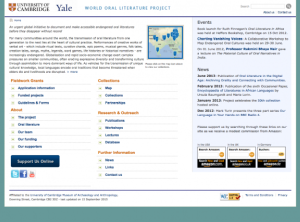 |
|
World Oral Literature Project
|
Language Arts |
|
The World Oral Literature Project, a collaboration between the University of Cambridge Museum of Archeology and Anthropology and Yale University, is a recent initiative to document and preserve oral literature around the world. Between 2009 and 2013, project researchers worked with communities around the world to collect oral literature in a number of endangered languages. Oral literature, as the website explains, is "a broad term which may include ritual texts, curative chants, epic poems, musical genres, folk tales, creation tales, songs, myths, spells, legends, proverbs, riddles, tongue-twisters, word games, recitations, life histories or historical narratives." Visitors may explore the complete World Oral Literature Project collection - as well as a number of donated collections - via the Collections list (organized by head researcher, title, and date) or by using the Map, which charts each project by geographic area. In addition to audio recordings, there are videos, photographs, and more relating to over 30 languages and the communities that speak them. The World Oral Literature Project focuses specifically on languages spoken in Asia and the Pacific; however, the collection also includes languages spoken in other regions, including Sierra Leone, Egypt, and Greenland. [MMB] |
|





|
|
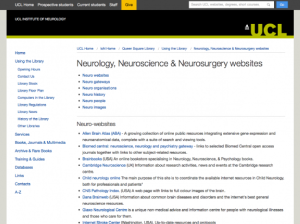 |
|
Neurology, Neuroscience, and Neurosurgery Websites
|
Science |
|
For neuroscience professionals, educators, and students, the University of London's Queen Square Library has compiled this extensive resource list of websites related to the history, science, and practice of neurology, neuroscience, and neurosurgery. These resources are helpfully annotated and sorted into categories. For example, in the Neuro-websites category, visitors will find a diverse selection of educational websites as well as links to more specific research lists. Meanwhile, in Neuro-history, visitors will find resources related to the history of neurology as well as the history of science and medicine more broadly. Educators may be especially interested in the Neuro-images section, which highlights sources of photographs and videos that may be of use in the classroom. Many of these images may also be appreciated by members of the general public interested in learning more about neuroscience. [MMB] |
|





|
|
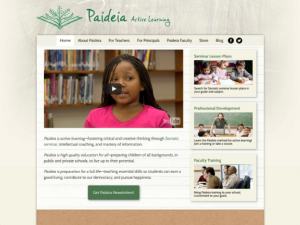 |
|
Paideia: Active Learning
|
Philosophy |
|
Paideia is a pedagogical method that centers on Socratic seminars, or group discussions with open-ended questions. On this website from the National Paideia Center, educators can learn more about the Paideia method and download lesson plans for both K-12 students and adult learners. As of this write up, this website includes over 70 lesson plans, which teachers can browse by subject (Art, English and Language Arts, Math, Science, and Social Studies) or by grade level. While some lesson plans require a paid subscription, many can be accessed by creating a free account. Lesson plans, along with accompanying classroom readings and resources, can be easily downloaded in PDF format. Lesson topics range from the Gettysburg Address to the Periodic Table of Elements to the book, Where the Wild Things Are. Interested teachers may also sign up to receive a free newsletter from the organization. [MMB] |
|





|
|
 |
|
 |
|
Digital Library for Decorative Arts and Material Culture
|
Arts |
|
From the University of Wisconsin Digital Collections comes The Digital Library for Decorative Arts and Material Culture, an extensive digitized library featuring archival materials that will be of interest to art historians and lovers of material culture. These materials, which span the seventeenth through the twentieth centuries, include journals, illustrated natural history guides, design manuals, architectural sketches, and more. Visitors can browse this collection by item or by author. A few of the many gems in this collection include the complete archives of The Craftsman, a monthly journal published between 1900-1916; the four volume American Ornithology, or, the natural history of birds inhabiting the United States, not given by Wilson, with figures drawn, engraved, and colored for nature, authored by Charles Lucien Bonaparte between 1825 and 1833; and the complete text of the 1898 book, The Decoration of Houses, co-authored by novelist Edith Wharton and architect Ogden Codman, Jr. [MMB] |
|





|
|
 |
|












